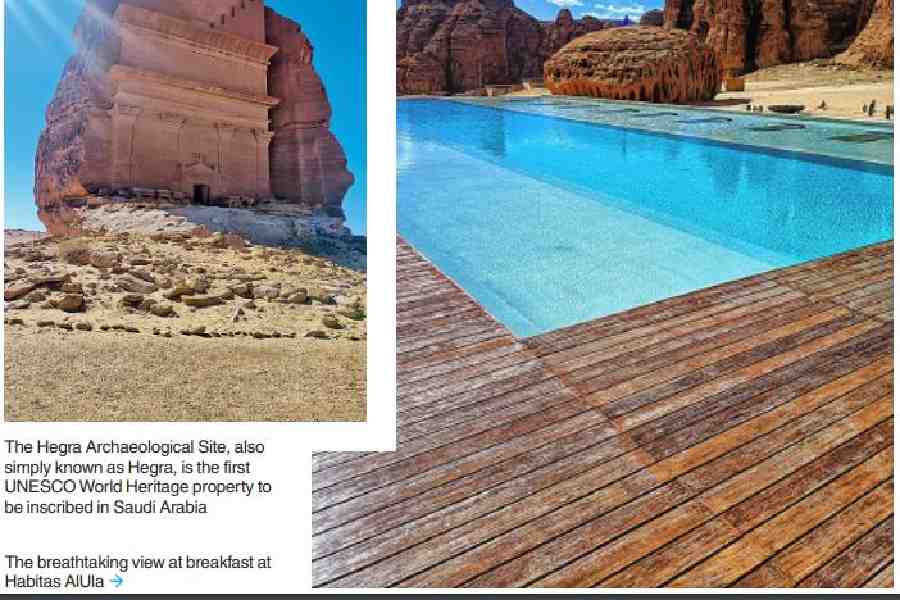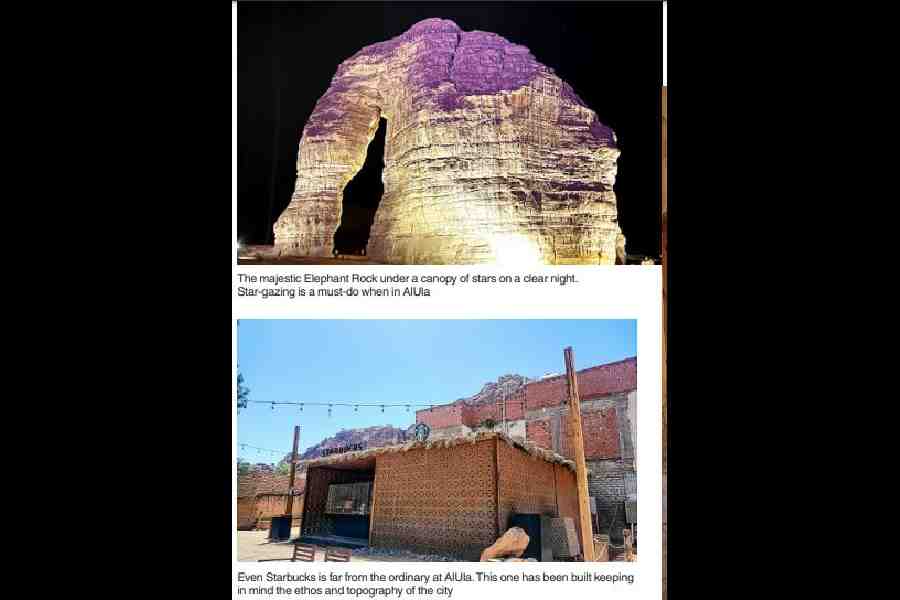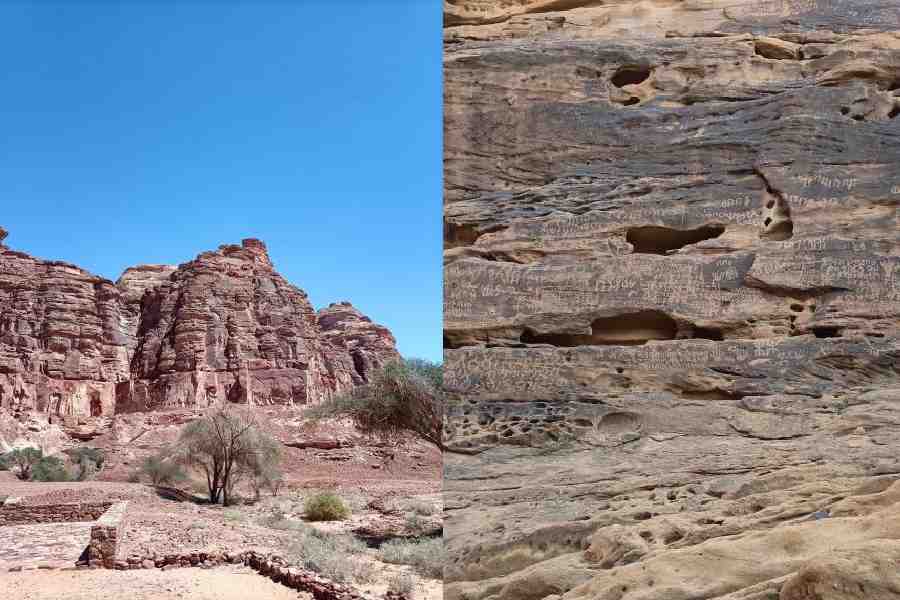The first time I ever heard of AlUla was only last year. Hollywood heartthrob Gerard Butler was filming his espionage thriller Kandahar in AlUla, I read somewhere. Being unfamiliar with the name but as intrigued by it as I was with Timbuktu when I first heard of it as a child, I quickly Googled ‘AlUla’. What greeted me were immensely attractive images of a sprawling desert town in Saudi Arabia. A quick read told me that AlUla was an ancient Arabic oasis city located in the Medina province of northwestern Saudi Arabia. Situated in the Hejaz, a region that features prominently in the history of Islam as well as several pre-Islamic Semitic civilisations, AlUla, also stylistically written as Al-’Ula, was a market city on the historic incense route that linked India and the Gulf to the Levant and Europe. I was instantly enchanted.
A few months later, as luck would have it and courtesy of the hospitality of Tourism AlUla, I was taking in the sights of the city seated in a helicopter and pretty much feeling the vibe of the tale of the magical carpet in Scheherazade’s One Thousand and One Nights. My ride flew over the sun-specked geology of AlUla, comprising sand-drifted canyons, red-rock cliff faces, unique outcrops, untouched wilderness and rock formations — all surrounded by seas of desert sand deposits. These imagination-spurring rock formations add to the wonder of AlUla, with many of them having naturally taken the forms of humans, animals and architectural structures.
I have experienced heli-rides over the pristine glaciers of Queenstown in New Zealand, the verdant wine country of Western Australia and taken in the jaw-dropping Manhattan skyline. But the one I experienced over AlUla was different. ‘Exotic’ doesn’t even begin to describe it. As does the rest of what I got up, close and personal with during my weeklong stay at AlUla.
A CITY OF THE FUTURE & THE PAST
The uniqueness of AlUla lies in the fact that it can be both a city of the future as well as of the past. Even as it aims to build a futuristic city complete with state-of-the-art hotels and resorts, museums and avant-garde buildings, AlUla’s ethos lies pretty much in its rich past. A ride through the virtually deserted city — its population density is negligible compared to its sprawling expanse — throws up archaeological marvels all around. The mountainous formations that naturally dot both sides of the road in this city may appear the same, but each one — in character and build — is different.
There are the surprisingly well-preserved ruins of the city of Dadan. Built meticulously from stone and sitting astride the valley’s oasis, Dadan dates back between the late ninth and early eight-century BCE (Kingdom of Dadan) and fifth–second century BCE (Kingdom of Lihyan). Dadan, in its early phase, was said to be “one of the most important caravan centres in northern Arabia” and is also mentioned in the Hebrew Bible.
What I got to see of Dadan on a sunny spring morning were familiar rock formations, many of which were etched with tombs that its inhabitants used to commemorate its dead people. Lions carved into the rockface adorn two particular tombs built into the mountains of Dadan. Being on a major trading route, Dadan was inevitably exposed to other cultures. Archaeologists have found a whole fortified city buried under the sand, and influences from other cultures are apparent in their statues, the decoration of their buildings and their tombs. A slight distance away from the ruins of Dadan is the wondrous Jabal Ikmah. Thousands of preArabic inscriptions across numerous sites make AlUla an important location for studying the Arabic language, with Jabal Ikmah being the pick of the lot. The rocks around this mountain are filled with so many carvings that it came to be referred to as an “open library”, one of the largest in the world. Languages represented in these inscriptions include Aramaic, Dadanitic, Safaitic, Thamudic, Minaic and Nabataean, all languages that predated and eventually influenced Arabic. The fact that all these scripts and languages have been deciphered increases the historical significance of Jabal Ikmah. I spent a great deal of time doing a hop, skip and jump from one crevasse to another here, marvelling at the remarkable clarity and creativity of the carvings, each of which had a distinct story to tell. Given that I am quite a history buff, that afternoon at Jabal Ikmah — which was followed by me trying my luck at carving my name in the ancient Dadanitic script on a piece of stone, without much luck, I may add — remains a memorable part of this trip.

THE WONDER OF HEGRA
The most famous — and undoubtedly, the most Instagramworthy, a critical box-checker in today’s times — tourist attraction in AlUla is Hegra. The Hegra Archaeological Site, also simply known as Hegra, is the first UNESCO World Heritage property to be inscribed in Saudi Arabia. Looming large and enchanting even from afar, Hegra, sprawled over a huge distance, is the largest conserved site of the civilisation of the Nabataeans, south of Petra in Jordan. It features well-preserved monumental tombs with decorated facades dating from the 1st century BC to the 1st century AD. The site also features some 50 inscriptions of the pre-Nabataean period and some cave drawings. Even a whole day at Hegra isn’t enough, I quickly learnt. Each of the tombs has its own story to tell, with a peek inside them giving one an idea of the kind of life and culture of that period. Hegra’s archaeological vestiges are often compared to Petra, with Qasr alFarid, which means ‘Lonely Castle’, given that it is the only one located in isolation from the other tombs which are in clusters, being the one you will find in most pictures accompanying a description of this stunning historical site.
THE OLD...
AlUla, which is gradually throwing itself open to the discerning traveller — one who has an interest in history or luxury or preferably both — dates back to the sixthcentury BC. A walled city, AlUla was an oasis in the desert with fertile soil and plenty of water. A walk through the Old Town of AlUla, comprising its labyrinth of nooks and alleys and remnants of tightly packed mud-brick homes, which illustrated life in the past, took me back several thousand years right into the middle of a once-thriving settlement. As did a walk up the steep steps of the AlUla Castle, often referred to as AlUla Fort as well as Musa Bin Nusayr Castle. If you manage to make it to the top — as I did with a little huff here, a little puff there — you will be rewarded with a panoramic view of AlUla.
...AND THE NEW
AlUla’s vision of the future is best exemplified by Maraya. Meaning ‘reflection’ or ‘mirror’ in Arabic, that’s what Maraya precisely is — the world’s largest mirror building, an architectural accomplishment like few others. A remarkable multipurpose conference and functions venue which also houses an immersive Andy Warhol exhibition and a state-of-the-art restaurant — Maraya Social owned by Jason Atherton, the man behind three Michelin-starred restaurants — Maraya looms large in the middle of the desert, mirroring the vast AlUla landscape. It’s an aweinspiring piece of architecture which took only two-and-a-half months to be made. It’s unlike any man-made structure I have seen so far, appearing as magnificent from the air as it does from the ground. Another great example of Saudi Arabia, and particularly of AlUla, harnessing its natural topography for tourism is the gigantic Elephant Rock. Soaring 52 metres into the sky, Elephant Rock is considered to be AlUla’s most iconic geological marvel. The instantly recognisable form, with its distinctive trunk and body, was shaped by wind and water erosion over the course of millions of years. Today, it is a major tourist attraction. I suggest you visit it at night, as I did, to get an otherworldly view of Elephant Rock under a canopy of luminous stars. In fact, star-gazing is one of the primary attractions at AlUla, the almost-zero pollution levels resulting in a clear sky almost every night. At Elephant Rock, you can enjoy the spectacle from sunken seating dotted around the site, or gather around a roaring fire pit to warm up on cooler desert nights. It’s a beautiful experience.
... AND THE REST
My AlUla travelogue would well and truly be incomplete without a mention of Habitas. This state-of-theart (one is bound to use this descriptor pretty often in AlUla) luxury five-star resort nestled in the heart of the desert canyon of Ashar Valley is a paradise in the truest sense of the word. Just stick a camera anywhere at Habitas — the view at breakfast is breathtaking — and you will have enough pictures to fill half, or more, of your gallery. And yes, Gerard Butler was here!







